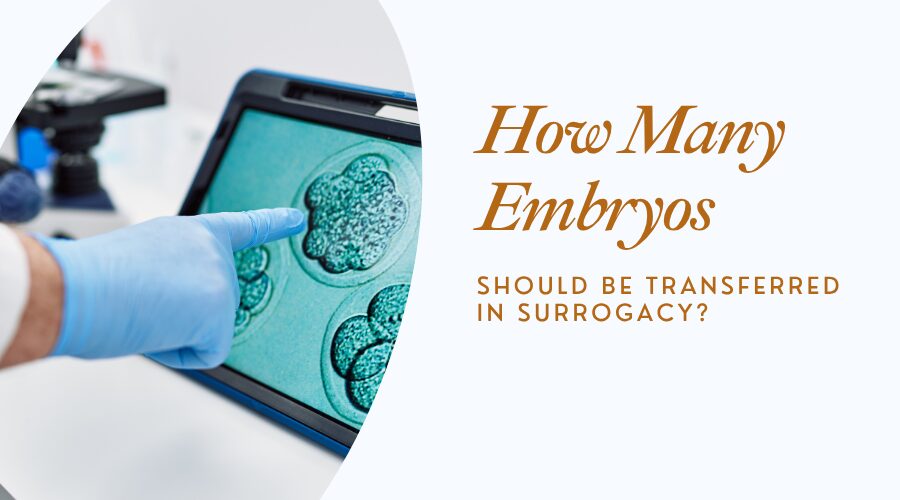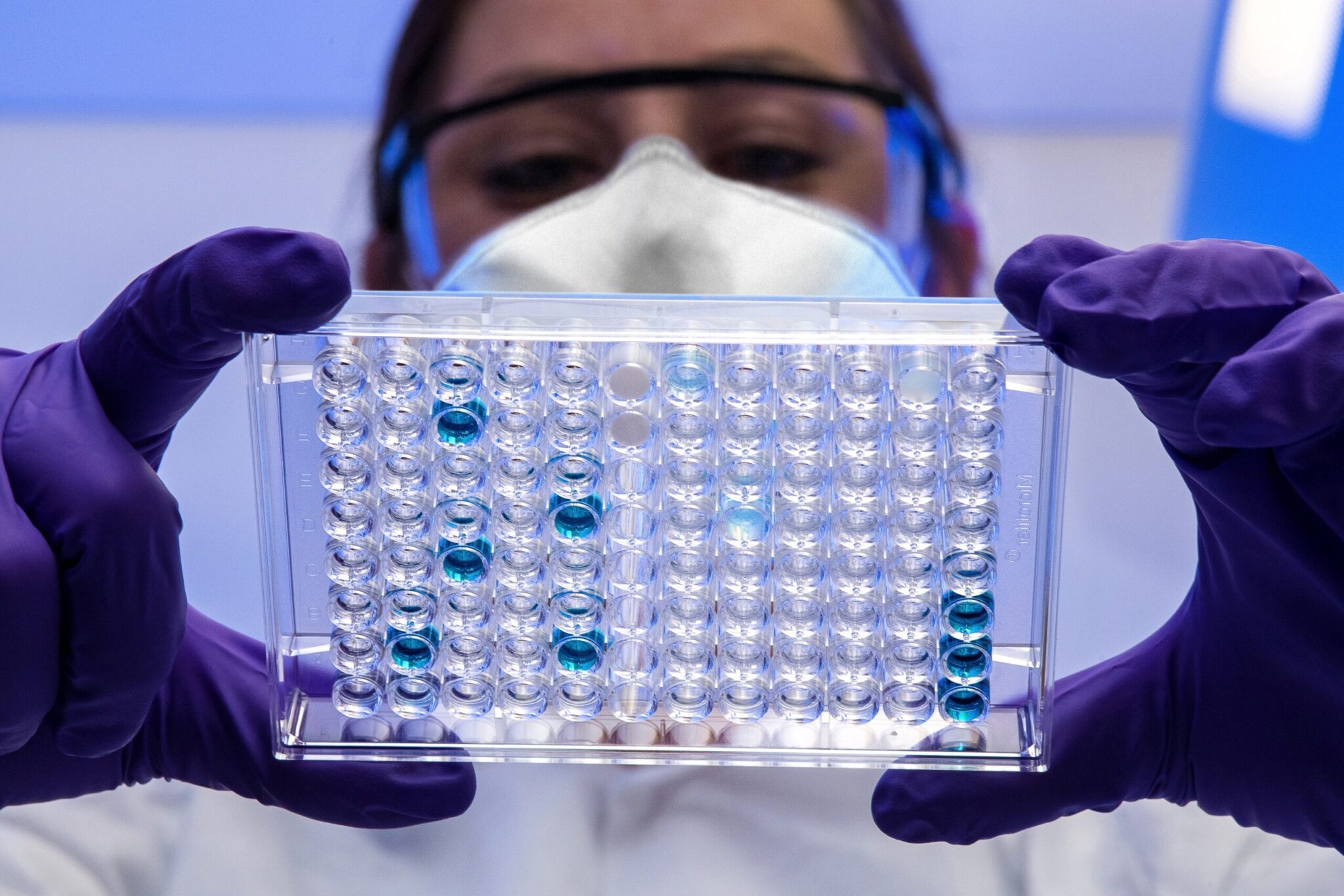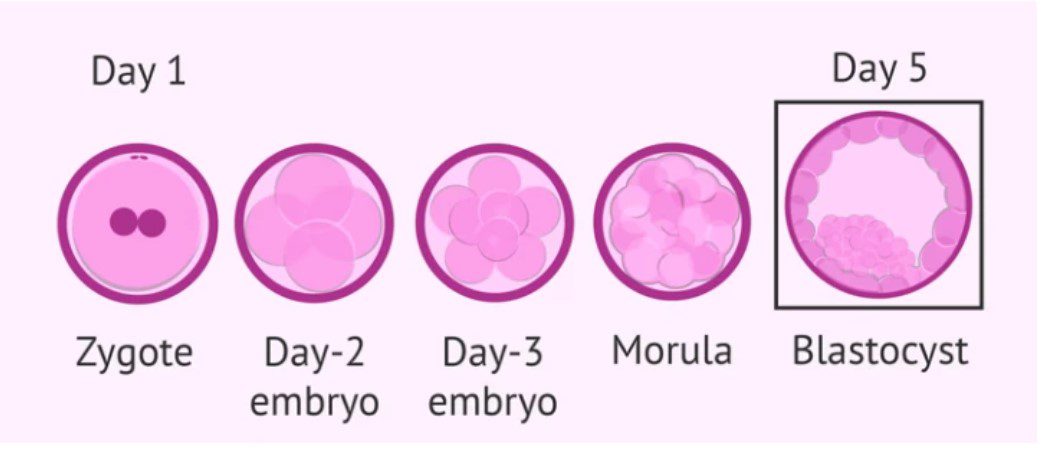How Many Embryos Should Be Transferred in Surrogacy: Your Guide

Embryo transfer is a crucial step in the surrogacy journey, determining both the success of the pregnancy and the health of the surrogate and baby. Intended parents often face the dilemma of single vs. multiple embryo transfer, weighing factors like success rates, risks, and legal regulations. Understanding the factors that influence this decision is essential for making informed choices.
So, many intended parents ask us, how many embryos should be transferred in surrogate mother? Well, it is advised to transfer one blastocyst embryo which is generically tested via PGS for optimum success and safety for a surrogacy journey. For individual case, embryo quality, fertility considerations, and surrogate guidelines all play a role in successful surrogacy outcomes. In vitro fertilization (IVF) is a cornerstone of the surrogate process, and the number of available embryos can shape the journey.
While it might seem logical to transfer multiple embryos to increase the chances of pregnancy, this approach carries risks, including complications for the surrogate and the potential for multiple pregnancies.
Interestingly, even a single high-quality embryo can lead to a successful pregnancy. Advances in fertility treatments, such as preimplantation genetic testing (PGT), have improved the likelihood of success with single embryo transfers. Modern medical techniques emphasize quality over quantity, offering hope to those with limited embryos.
By balancing these factors and working closely with fertility specialists and surrogacy experts, you can make decisions that align with your goals and priorities. This article will guide you through the key considerations and provide actionable insights to help you navigate this important decision.
Key Takeaways
- Determining the right number of embryos to transfer is crucial for surrogacy success.
- Embryo quality and fertility factors significantly influence outcomes.
- Single embryo transfers can be highly effective, especially with advanced testing.
- Multiple embryo transfers increase the risk of complications.
- Single embryo transfer (SET) is safer and recommended for most surrogacy cases.
- Multiple embryo transfer (MET) increases pregnancy chances but also risks complications.
- Medical guidelines from ASRM and ESHRE strongly favor elective single embryo transfer (eSET).
- Legal restrictions vary—some countries limit embryo transfer to one or two embryos.
- Consulting a fertility specialist is crucial for making the best decision.
📞 Get in Touch for a Free Surrogacy Consultation
📱 +91-8800481100 (WhatsApp | LINE | Viber)
📧 neelam@ivfconceptions.com
🌐 www.ivfconceptions.com
Additional Resources:
How Much Does Surrogacy Cost Using Family Member
Can My Insurance Provider Pay My Surrogacy Costs?
How Much Does Surrogacy Cost in the USA?
Surrogacy Costs Breakdown for Intended Parents

Understanding the Role of Embryo Transfer in Surrogacy
Embryo transfer is a pivotal step in the surrogacy process, directly influencing the success of the journey. For intended parents, this procedure is more than a medical step—it’s a hopeful moment toward building their family.
Understanding Embryo Transfer in Surrogacy
Embryo transfer involves implanting one or more embryos into a gestational surrogate’s uterus during an in vitro fertilization (IVF) cycle. The number of embryos transferred significantly impacts pregnancy success rates and potential complications.
Embryo Quality and Viability
The success of an embryo transfer largely depends on the quality and viability of the embryos. High-quality embryos, often identified through advanced techniques like preimplantation genetic testing (PGT-A), significantly improve implantation rates. PGT-A helps identify genetically healthy embryos, reducing the risk of complications and increasing the chances of a successful pregnancy.
| Embryo Quality Factors | Impact on Implantation | Recommendations |
| High-quality embryos with PGT-A | Higher implantation success rates | Recommended for single embryo transfer |
| Lower quality embryos | Reduced implantation success | Consider multiple embryo transfer with medical guidance |
| Genetic abnormalities | Lower success rates and higher risks | Avoid transfer; consider other options |
Single vs. Multiple Embryo Transfer: Which is Better?
| Factor | Single Embryo Transfer (SET) | Multiple Embryo Transfer (MET) |
| Success Rate | High with PGT-tested embryos | Higher chances of implantation but diminishing returns with more embryos |
| Risk of Multiple Pregnancy | Almost none | High risk of twins/triplets, leading to pregnancy complications |
| Health Risks | Lower risk of premature birth, gestational diabetes, and preeclampsia | Increased risk of miscarriage, preterm labor, and C-section |
| Medical Recommendations | Recommended for first attempts and for surrogates with a proven track record | Considered when previous cycles failed or for older intended parents |
| Legal & Ethical Considerations | More aligned with global fertility guidelines | Some countries limit the number of embryos that can be transferred |

Success Rates of Embryo Transfer in Surrogacy
The success of an embryo transfer depends on:
- Embryo quality – Higher success rates with PGT-tested embryos
- Surrogate’s health – Proven fertility history increases implantation chances
- Age of intended mother or egg donor – Younger eggs have higher success rates
- Previous IVF failures – More embryos may be transferred in certain cases
Success Rate Statistics
- Single embryo transfer (SET): 60-70% success rate with high-quality embryos
- Double embryo transfer (DET): Increases pregnancy chances to 70-80% but raises multiple pregnancy risks
Risks of Transferring Multiple Embryos
While transferring multiple embryos may increase pregnancy chances, it significantly raises health risks:
For the Surrogate
❌ Higher chances of gestational diabetes, preeclampsia, and high blood pressure
❌ Greater likelihood of C-section delivery
❌ Increased risk of miscarriage and premature labor
For the Babies
❌ Higher chance of low birth weight and premature birth
❌ Increased risks of developmental delays and NICU stays
❌ Greater possibility of twin-to-twin transfusion syndrome (TTTS) in identical twins
Fertility measures and IVF techniques play a crucial role in optimizing embryo selection. Modern IVF processes enhance the likelihood of selecting viable embryos, improving overall surrogacy outcomes. Intended parents benefit from understanding how embryo quality directly affects implantation rates, as this knowledge helps in making informed decisions.
Recent clinical research underscores the benefits of transferring a single, high-quality embryo. This approach minimizes risks associated with multiple pregnancies, such as premature birth and low birth weight, while maintaining high success rates. By focusing on quality, intended parents can achieve a healthy, successful birth with confidence.

Key Factors Influencing Embryo Transfer Decisions
When considering embryo transfer, several personal and medical factors come into play. These elements help determine the optimal number of embryos to transfer, balancing success rates with health risks. Age, genetic profile, and clinic guidelines are among the most influential factors.
Age Considerations and Genetic Testing
A woman’s age significantly impacts both embryo quality and the recommended number for transfer. According to ASRM guidelines, younger women typically have higher-quality embryos, reducing the need for multiple transfers. Genetic testing, such as preimplantation genetic testing (PGT-A), further enhances embryo viability assessment, lowering the risk of genetic abnormalities and complications.
Embryo Grading and Clinic Recommendations
Clinics use specific grading systems to evaluate embryos, helping determine the optimal number to transfer. Higher-grade embryos often lead to better outcomes, even with fewer transfers. These assessments, combined with patient-specific data, guide personalized treatment plans, ensuring decisions align with individual health and success goals.
| Age Group | Recommended Embryos to Transfer | ASRM Guidelines |
| Under 35 | 1 euploid embryo | ≤2 embryos if not euploid |
| 35-37 | 1 euploid embryo | ≤3 embryos if not euploid |
| 38-40 | 1 euploid embryo | ≤3 cleavage-stage or ≤2 blastocysts |
| 41-42 | 1 euploid embryo | ≤4 cleavage-stage or ≤3 blastocysts |
These guidelines aim to minimize health risks while maximizing success rates, emphasizing the importance of tailored approaches in embryo transfer decisions.
Medical Guidelines for Embryo Transfer in Surrogacy
Leading fertility organizations recommend limiting embryo transfer to reduce risks:
- American Society for Reproductive Medicine (ASRM): Encourages single embryo transfer (SET) for optimal health outcomes
- European Society of Human Reproduction and Embryology (ESHRE): Advocates for elective single embryo transfer (eSET) when possible
- World Health Organization (WHO): Advises against transferring more than two embryos due to increased risks

Legal Restrictions on Embryo Transfer by Country
Some countries regulate the number of embryos that can be transferred to minimize risks:
| Country | Embryo Transfer Limit |
| United States | No federal limit; ASRM recommends SET in most cases |
| United Kingdom | Maximum 2 embryos (or 1 embryo if under 37) |
| Canada | Generally 1 embryo, with exceptions for older intended parents |
| Australia | Strong preference for single embryo transfer (SET) |
| India | Allows multiple embryos per cycle |
| Ukraine & Georgia | Multiple embryo transfers allowed but SET preferred for surrogacy |
How many embryos should be transferred in surrogate
Deciding on the number of embryos to transfer is a critical step in surrogacy. It’s a decision that balances success rates with health risks for both the surrogate and the baby. Understanding the factors that influence this choice is key to making informed decisions.
Single vs. Multiple Embryo Transfer
Transferring a single embryo can lower the risk of multiple pregnancies, which are linked to higher health risks. However, some cases may benefit from transferring multiple embryos to boost the chance of success. Modern techniques like preimplantation genetic testing (PGT) have improved the success rates of single embryo transfers.
Personalized Treatment Approaches
Each situation is unique, and the decision should be tailored to individual circumstances. Factors like embryo quality, age, and medical history play a significant role. Working closely with fertility experts ensures a plan that aligns with your goals and minimizes risks.
Research shows that single embryo transfers can be as effective as multiple transfers, especially with high-quality embryos. This approach reduces the chance of complications while maintaining a high success rate. Personalized plans help intended parents and surrogates make decisions that prioritize health and success.
Factors to Consider When Choosing the Number of Embryos
Before deciding how many embryos to transfer, intended parents and their fertility specialists should consider:
✔️ Surrogate’s medical history – Has she successfully carried a pregnancy before?
✔️ Embryo quality – Are the embryos genetically tested (PGT)?
✔️ Desired pregnancy outcome – Are the intended parents open to twins/multiples?
✔️ Legal restrictions – What are the laws in the surrogacy destination?
✔️ Medical recommendations – What do the doctors advise based on risks?

Risks, Guidelines, and Best Practices for Embryo Transfer
Embryo transfer is a critical step in surrogacy, requiring careful consideration of both medical and ethical factors. Understanding the potential risks and adhering to established guidelines is essential for ensuring a safe and successful process for all parties involved.
Understanding the Health Risks of Multiple Pregnancies
Transferring multiple embryos increases the likelihood of multiple pregnancies, which carry significant health risks for both the surrogate and the babies. These risks include preterm birth, low birth weight, and other complications that can affect maternal and fetal health. Research indicates that multiple pregnancies are associated with higher rates of gestational diabetes, preeclampsia, and placental complications, all of which can have long-term consequences.
- Preterm birth and low birth weight are common in multiple pregnancies.
- Complications like gestational diabetes and preeclampsia are more frequent.
- Long-term developmental challenges for children may arise.
ASRM Recommendations and Safety Protocols
The American Society for Reproductive Medicine (ASRM) provides clear guidelines to minimize these risks. ASRM strongly recommends elective single embryo transfer (eSET) for most candidates, especially those under 38 years of age. This approach reduces the risk of multiple pregnancies while maintaining high success rates. Studies show that eSET does not significantly lower overall birth rates compared to transferring multiple embryos, making it a safer choice.
- ASRM guidelines emphasize eSET for reduced complications.
- Single embryo transfer maintains high success rates.
- Regular counseling is crucial for informed decision-making.
By adhering to these guidelines and prioritizing safety, intended parents and surrogates can navigate the surrogacy process with confidence, ensuring the best possible outcomes for everyone involved.
Conclusion: What’s the Best Choice?
The decision on how many embryos to transfer depends on individual medical, ethical, and legal factors. While multiple embryo transfer may seem appealing, most experts recommend single embryo transfer (SET) for a safer, healthier pregnancy.
Making informed decisions about embryo transfer in surrogacy is a delicate balance between success and risk.
Age, genetic profile, and clinic guidelines are key influences in determining the optimal number of embryos to transfer. For instance, younger women typically have higher-quality embryos, reducing the need for multiple transfers.
ASRM guidelines recommend single embryo transfers for women under 38, emphasizing safety and success. Modern techniques like PGT-A have revolutionized surrogacy, offering hope with fewer risks.
📞 Get in Touch for a Free Surrogacy Consultation
📱 +91-8800481100 (WhatsApp | LINE | Viber)
📧 neelam@ivfconceptions.com
🌐 www.ivfconceptions.com
💫 Why Intended Parents Choose Complete Surrogacy for a Safe, Smooth & Successful Surrogacy Journey:
🌍 Access to multiple surrogacy destinations with 15+ years of international experience
🏥 Partnerships with top-tier fertility clinics and agencies, backed by references from past clients
👩🦱 Diverse egg donor options: Asian, Caucasian, African, Oriental, and more
💸 Transparent and affordable pricing—direct payments with no extra agency fees
🔒 No hidden costs—all charges are agreed upon upfront
🤝 Dedicated case manager for personalized support
📲 Fast, honest, and clear communication throughout
📑 Full legal support for visas, documentation, and baby exit processes
🚚 Assistance with frozen sperm/embryo shipment logistics

FAQs for how many embryos should be transferred in surrogacy
What factors determine the number of embryos transferred in surrogacy?
The decision is based on factors like the age of the egg donor, embryo quality, and medical history. Clinics often recommend single embryo transfer to reduce the risk of multiple pregnancies, which can pose health risks for both the surrogate and the babies.
What are the risks of transferring multiple embryos?
Transferring multiple embryos increases the chance of multiple pregnancies, which can lead to complications like preterm birth and low birth weight. Single embryo transfer is generally safer and reduces these risks while maintaining a high success rate.
How does embryo quality impact the transfer decision?
High-quality embryos are more likely to result in a successful pregnancy. Embryo grading and genetic testing can help identify the best candidates, often allowing for a single transfer and reducing the need for multiple embryos.
What role does the surrogate’s health play in embryo transfer?
The surrogate’s health and uterine environment are critical. A healthy uterus can support a single embryo, while multiple transfers may strain the surrogate’s body and increase pregnancy risks.
How do clinics determine the optimal number of embryos to transfer?
Clinics consider age, egg quality, and implantation rates. They may also use guidelines from organizations like the ASRM (American Society for Reproductive Medicine) to recommend the safest and most effective approach.
What are the benefits of single embryo transfer?
Single embryo transfer lowers the risk of multiple pregnancies, reduces complications, and often results in a healthier pregnancy and birth. It also aligns with ethical surrogacy practices that prioritize health and safety for all parties involved.
Can intended parents choose to transfer more than one embryo?
While possible, transferring multiple embryos is typically discouraged due to the increased risks. Clinics may require counseling to ensure intended parents understand the potential complications and long-term health impacts for the surrogate and children.
How does age affect the number of embryos transferred?
Younger individuals may achieve success with a single embryo, while older individuals might consider transferring more due to lower egg quality and implantation rates. However, this is carefully balanced against the risks of multiple pregnancies.
What role does insurance play in embryo transfer decisions?
Insurance coverage can influence decisions, as some policies may cover only a certain number of transfers or embryos. Clinics work with intended parents to balance cost, success rates, and health considerations.
How are frozen embryos handled in surrogacy?
Frozen embryos are commonly used in surrogacy. They are thawed and transferred as needed, allowing for personalized treatment plans and reducing the need for multiple transfers in a single cycle.
What are the success rates of single versus multiple embryo transfers?
Single embryo transfers have high success rates, especially with advanced fertility treatments and genetic testing. Multiple transfers may slightly increase success rates but at the cost of higher risks.
How are surrogates protected during embryo transfer?
Surrogates are protected through medical screening, legal agreements, and careful monitoring of their health throughout the process. Clinics prioritize their well-being to ensure a safe and successful journey.
What are the legal considerations for embryo transfer in surrogacy?
Legal agreements outline the rights and responsibilities of all parties, including the number of embryos transferred. This ensures ethical practices and protects the interests of intended parents, surrogates, and the children.
Source Links
- https://www.pfcla.com/blog/ivf-and-surrogacy – Understanding Surrogacy and IVF
- https://progyny.com/education/understanding-the-surrogacy-process/ – Understanding the Surrogacy Process | Progyny
- https://www.asrm.org/practice-guidance/practice-committee-documents/guidance-on-the-limits-to-the-number-of-embryos-to-transfer-a—committee-opinion-2021/ – Guidance on the limits to the number of embryos to transfer: a committee opinion (2021)
- https://pmc.ncbi.nlm.nih.gov/articles/PMC5846681/ – Deciding how many embryos to transfer: ongoing challenges and dilemmas

